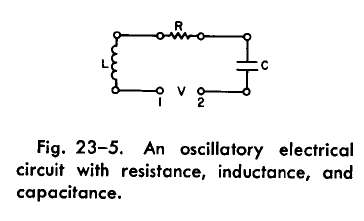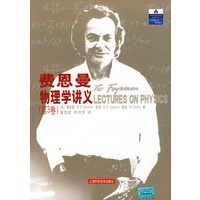《费恩曼物理学讲义》第1卷,[美]费恩曼(R.P.Feynman)、莱顿(R.B.Leighton)、桑兹(M.Sands)著,郑永令、华宏鸣、吴子仪等译,上海科学技术出版社,2005年6月第1版,2012年1月第10次印刷。
第2章 基本物理,第11页:实际上我们今天还没有找到所有规则(时而会出现一些像弈棋中的“以车护王”那样的情况,使我们仍然感到无法理解)。
这句话中的“以车护王”应该是“王车易位”。英文原文是:
A ctually, we do not have all the rules now. (Every once in a while something like castling is going on the we still do not understand.)
第6章 概率,第63页:我们这里所描述的概率密度函数是最经常遇到的一种,通常把它称为正常或高斯概率密度,它的数学形式是...
这句话中的“正常”应该是“正态”。英文原文是:
The probability density function we have been describing is one that is encountered most commonly. It is known as the normal or gaussian probability density. It has the mathematical from ...
第6章 概率,第65页:图 6-10 观察一个粒子的位置与速度时的概率密度 (b) 图中,[△x] 应改为 [△v]。英文版的是正确的。
第7章 万有引力理论,第72页:应用引力定律我们还能做别的什么叫呢?如果我们看一下木星的月球,那么我们就能知道它们怎样围绕这个行星运行的一切情况。
这句话中的“月球”应该是“卫星”。英文原文是:
What else can you do with the law of gravitation? If we look at the moons of Jupiter we can understand everything about the way they move around that planet.
根据“必应词典”对 moon 的解释:n. 1.月亮;月球。2.卫星。例句:How many moons has Jupiter got? 木星有多少颗卫星?
在这里 moon 应该翻译成“卫星”,而不应该翻译成“月球”。这个自然段中还有五处这样的情况。
第7章 万有引力理论,第77页:现在,所有月球、行星和恒星都由这样一条简单的规则来支配,并且,人们能够理解它,从它推论出行星应当如何运动!
这句话中的“月球”应该是“卫星”。英文原文是:
... this fact that all the moons and planets and stars have such a simple rule to govern them, and further that man could understand it and deduce how the planets should move!
第8章 运动,第83页:现在我们的意思是,只要她再多开一点点的时间,那么汽车所通过的外加距离就和一辆以 60 mi · s-1 的稳定速率开动的汽车相同。也许 88 ft · s-1 的观念是正确的,我们看看她在最后一秒种开了多远,再除以 88 ft,如果结果是 1,那么速率就是 60 mi · s-1。
这句话中的两处“60 mi · s-1”都应该改为“60 mi · h-1”。英文原文是:
Now what that means is that if she went just a little bit more in time, the extra distance she goes would be the same as that of a car that goes at a steady speed of 60 miles an hour. Perhaps the idea of the 88 feet per second is right; we see how far she went in the last second, diide by 88 feet, and if it comes out 1 the speed was 60 mile an hour.
第8章 运动,第84页:在最后 0.001 s 内球落下了 0.160 016 ft,如以 0.001 s 除以这个数字,就得到速率为 160.016 ft · s-1。
这句话中的“除以”应改为“除”。英文原文是:
In the last 0.001 sec the ball fell 0.160016 ft, and if we divide this number by 0.001 sec we obtain the speed as 160.016 ft/sec.
第8章 运动,第86页:表 8-3 求导简表 中,s = uavbwc 应改为 s = uavbwc… 。 英文版中是正确的。
第12章 力的特性,第131页:如果用场的概念来分析这个力,我们说P处的电荷q1在R处产生了一种“条件”,而当电荷q2被置于R处时,它就“感受”到为这个作用力。... 我们说E是由q1产生的“状况”,F是q2对于E的响应。
这句中的“条件”应改为“状况”。英文原文是:
To analyze this force by means of the field concept, we say that the charge q1 at P produces a "condition" at R, such that when the charge q2 is placed at R it "feels" the force. ... E is the "condition" produced by q1, we say, and F is the response of q2 to E.
第13章 功与势能(上),第140页:这页中的 -GMm(1/r2 - 1/r1)、-GMm(1/r4 - 1/r3)、-GMm(1/r6 - 1/r5)、-GMm(1/r8 - 1/r7) 前面的“-”均应删除。相应地, W = GMm(1/r1 - 1/r2 + 1/r3 - 1/ r4 + 1/r5 - 1/r6 + 1/r7 - 1/r8) 应改为 W = GMm(1/r2 - 1/r1 + 1/r4 - 1/ r3 + 1/r6 - 1/r5 + 1/r8 - 1/r7)。
第13章 功与势能(上),第142页:= rij · (vi - vj) / rij = rij · vi / rij - rji · vj / rji 应改为 = rij · (vi - vj) / rij = rij · vi / rij + rji · vj / rji。
第13章 功与势能(上),第143页:(若dρ《ρ,2πρdρ就是半径为ρ、宽度为dP的圆球面积)
这句中的“dP”应改为“dρ”。
第14章 功与势能(下),第147页:我们刚才所说的一切都包含在 W = F · ds 这一式子中。
这句中的“ W = F · ds ”应改为“ W = ∫F · ds ”。
第14章 功与势能(下),第154页:这是从势能求得力的方法,我们以完全相同的方向从势能求得场强
这句话中,“方向”应改为“方法”,第二个“势能”应改为“势”。英文原文是:
This is the way to get from the potential energy to the force. We get the field from the potential in excatly the same way:
第15章 狭义相对论,第157页:在光的情况下,这种与声源运动的无关性引起了一个有趣的问题。
这句话中,“声源”应改为“光源”。英文原文是:
This independence of the motion of the source, in the case of light, brings up an interesting problem:
第15章 狭义相对论,第160页:公式(15.5)中的 应改为
。
因为下一句话是:现在我们就能比较两条光线所需的时间了。在(15.4)和(15.5)两式中,分子是相同的,它表示在装置静止不动的假定下光所取的时间。
而公式(15.4)是:。英文原文是正确的。
第17章 时空,第183页:假设,我们在测量时,一个物体具有速度 v,但是,我们是从以速度 v 运动的宇宙飞船上来观察这一物体的,所以我们把在宇宙飞船坐标系中测得的相应量都打上一撇。
这句话中,第二个“v”应改为“u”。英文原文是:
Suppose that, as we measure it, an object has a velocity v, but we look upon the same object from the point of view of a space ship which itself is moving with a velocity u, and in that system we use a prime to designate the corresponding thing.
第17章 时空,第186页:这种光子也带有一定的动量,光子(实际上,任何粒子)的动量等于波长除以普朗克常数:p = h / λ。
这句话中,“波长除以普朗克常数”应改为“普朗克常数除以波长”。英文原文是:
Such a photon also carries a momentum, and the momentum of a photon (or of any other particle, in fact) is h divided by the wavelength: p = h / λ.
第19章 质心、转动惯量,第199页:在大多数情况下,我们将仅限于研究三维物体,但是在三维情况下绕 z 轴转动的公式是完全相同的。
这句话中的“三维物体”应改为“二维物体”。英文原文是:
For the most part, we shall restrict ourselves to two-dimensional objects, but the formula for rotation about the z-axis is just the same in three dimensions.
第19章 质心、转动惯量,第201页:表19-2中,“长方形平行六面体,边长为a,b,c”应改为“长方体,棱长为a,b,c”。英文原文是:Rect. parallelepiped, sides a, b, c。
第21章 谐振子,第217页: v0 = ω0 A · 0 + ω0 B · 1 = ω0 B. 应改为 v0 = -ω0 A · 0 + ω0 B · 1 = ω0 B. 。英文原文是正确的。
第22章 代数学,第220页:假如开始时有某一个整数a,我们一个单位接一个单位地共数了b次,这样得到的一个数,我们称之为a + b,这就定义了整数的加法。
这句话翻译得不好。英文原文是:
If we start with a certain number a, an integer, and we count successively one unit b times, the number we arrive at we call a + b, and that defines addition of integers.
第22章 代数学,第224页:(可能有人还会提出这样的问题,是否存在某一个自然数,以它为底时,所有事情会变得更简单一些,以后我们会找出这个问题的答案。目前,我们仅采用以10为底)。
这句话中的“自然数”应改为“自然的底”。英文原文是:
(The question may arise as to whether there is any natural base, any base in which things are somehow simpler, and we shall try to find an answer to that later. At the moment we shall just use the base 10.)
这里说的是“natural base”,而不是“natural number”。显然,这个数应该是 e = 2.718...,即自然对数的底,这可是个无理数,也是超越数,而不是自然数。请参阅本书第226页。
第22章 代数学,第224页:其结果如表 22-1 所示。10 的幂指数列在第一行,而 10s 的值列在第三行。...... 如果在第一行中 s 的数目足够多,使得可以由它们构成几乎任何数,那么在第三栏中取适当的数相乘后,我们就能求出 10 的任何次幂。这就是我们的打算。这样,我们依次求出了 10 个 10 的平方根,这就是计算过程中的主要工作。
这段话中的三个“行”都应改为“列”,“栏”也可以改为“列”,“10 个 10 的平方根”应改为“10 的 10 个平方根”。英文原文是:
The results are shown in Table 22-1. The powers of 10 are given in the first column, and the result, 10s, is given in the third column. ...... If we can get enough numbers in column s to be able to make up almost any number, then by multiplying the proper things in column 3, we can get 10 to any power; that is the plan. So we evaluate ten successive square roots of 10, and that is the main work which is involved in the calculations.
第22章 代数学,第226页:很容易求出 e: e = 101/2.302 3 或 100.434 294...,是一个无理数幂。
这句话中的 “ 101/2.302 3 ” 应改为 “ 101/2.302 5 ”。英文原文是:
It is easy enough to find out what e is: e = 101/2.3025 or 100.434294..., an irrational power.
第22章 代数学,第228页:因此,我们确信当 s 很小时,比如说 s 是 i/1024,就能得到 10is 的一个相当好的近似值。
这句中的“i/1024”应改为“1/1024”。英文原文是:
So we assume that if s is very small, say one part in 1024, we have a rather good approximation to 10is.
第22章 代数学,第228页:但首先我们非常想找出对于怎样的 s 值,10is 的实部为零。此时,y 值将是 i,因此,应该有 10is = i,或 is = log10i。
这句中的“ y 值将是 i ”应改为“ y 值将是 1 ”。英文原文是:
But first we may be curious to find for what number s the real part of 10is is zero. The y-value would be i , and so we would have 10is = i , or is = log10i .
这里的英文原文也是错的。这里讨论的是 10is = x + iy 。并且根据(22.6)式,x2 + y2 = 1。由于 10is 的实部 x 为零,所以说,此时,y 值将是 1。
第23章 共振,第232页:公式(23.5) 应改为
。英文原文是正确的。
第23章 共振,第236页:图 23-5 由电阻、电容和电感组成的振荡电路 中,在端点1和端点2之间少了一个“v”。英文版的如下图所示:

第24章 瞬变态,第245页:公式(24.14) 应改为
。英文原文是正确的。
第24章 瞬变态,第245页:公式(24.15) 应改为
。英文原文是正确的。
第24章 瞬变态,第246页:公式(24.20) 应改为
。英文原文是正确的。
第24章 瞬变态,第247页: 应改为
。英文原文是正确的。
第25章 线性系统及其综述,第250页: 公式(25.6)下面第一行中的: 应改为
。英文原文是正确的。
第25章 线性系统及其综述,第257页: 应改为
。英文原文是正确的。
第25章 线性系统及其综述,第263页:在“图26-4 费马原理对折射的说明”中,“玻璃”应改为“水”。英文原文也是错误的。







 浙公网安备 33010602011771号
浙公网安备 33010602011771号